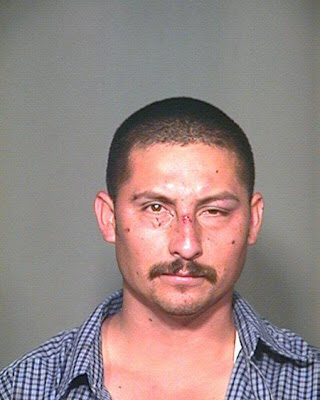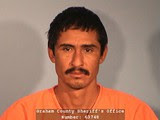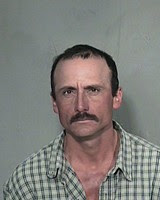
Manuel Osorio-Arellanes, who has a lengthy criminal record, was wounded in a gunfight with Border Patrol agents the night of Brian Terry's murder.
A tip of the boonie hat to Robert Farago who brought my attention to this story in the Tuscon Weekly, and a deep genuflection to Leo Banks for permission to copy this here. Be sure and check out his other border articles at the link.
Mike
III
The Brothers Arellanes
The man held in connection with the murder of Agent Brian Terry has a crime-ridden past—and so does at least one relative
by Leo W. Banks
Homeland Security Secretary Janet Napolitano's border strategy is to push as much of the illicit traffic as possible out of towns and settled areas, and into the backcountry.
Out of sight, out of mind. With the smugglers high up in the mountains and in remote canyons, she gains enough political cover to stand up and say the border is largely secure, so let's move on to comprehensive immigration reform.
But the strategy hasn't stopped the traffic; it's only moved it—into the neighborhoods of rural Southern Arizonans, which explains why these folks push back so loudly and so emotionally against the government spin.
Everything is on the line for them—their property, their families and their lives, as they try to stay away from dangerous smugglers crossing their land. They believe one of them killed rancher Rob Krentz in March 2010, and another murdered Border Patrol Agent Brian Terry along the Peck Canyon smuggling corridor, northwest of Nogales, on Dec. 14, 2010.
In the latter case, four men were arrested following the Terry incident—all illegal aliens. Three were judged not to be involved and were deported. The fourth, 34-year-old Manuel Osorio-Arellanes, is still being held for trial, now scheduled for May 10, on a felony charge of re-entry after deportation.
If you live along a smuggling corridor in the remote borderlands, or work for the Border Patrol and police those areas, men like Arellanes are your worst nightmare.
He was one of five armed men—part of a "rip crew" of border bandits who refused to drop their weapons when ordered to do so by agents from Border Patrol's elite BORTAC unit. In the deadly shootout that followed, Arellanes was wounded. He admitted carrying a rifle, according to an FBI search warrant, but claimed he did not fire when he realized the men they'd encountered were Border Patrol agents.
Arellanes' criminal past includes domestic violence, drug and alcohol abuse, and violence against police, according to records in Maricopa County. Moreover, Arellanes might've been working the Peck Corridor with Rito Osorio-Arellanes, who is believed to be Manuel's brother.
Daniel Osorio-Arellanes was formally deported from the U.S. on Oct 18, 2005.
Rito was arrested in the same area two days before Terry's murder.
Federal court records show that Rito—whose name, like Manuel's, is spelled in multiple ways in public documents—was taken into custody on Dec. 12 near Rio Rico. Smugglers, bandits and illegal aliens often enter and exit the Peck corridor at Rio Rico, which is close to Peck Well, the area of the Coronado National Forest where the murder occurred on Dec. 14.
After his arrest in Mesa on March 16, 2004, for selling $20 worth of crack cocaine to an undercover detective in Pioneer Park, Rito said if released, he would go live with his brother in Mesa. Rito was a transient at the time. Manuel was also was living in Mesa then, and in court records, both gave their address as Pasadena Street.
Rito also had a criminal record in this country, and he told a Maricopa County probation officer in 2004 that he had done time in Mexico for homicide. In a pre-sentencing report, the probation officer wrote that he did not verify that statement.
Rito's lawyer, Daniel Anderson, says he heard that Rito's brother had been shot by Border Patrol agents, but knew nothing more about it. As for Rito's past in Mexico, Anderson said he was unaware of it—and couldn't talk about it even if he were.
Rito Osorio-Arellanes, believed to be Manuel's brother, was arrested near Rio Rico two days before Brian Terry's murder.
The Tucson Weekly tried to confirm Rito's statement through the Mexican Foreign Ministry in Washington, D.C., but was unsuccessful as of our press time.
Were Manuel and Rito working together in Peck Canyon? Were they part of the same crew that was assaulting, raping and robbing illegals and rival drug mules using that corridor?
Court records also detail the border-area arrests of another man with the same last name: Daniel Osorio-Arellanes, 35. Like Rito, Daniel is from Sinaloa, Mexico.
Border Patrol arrested him on Oct. 20, 2008, near the border town of Sasabe, Ariz. Although the record is unclear, he was likely voluntarily returned to Mexico, which basically means he was pushed back across the line.
But the next day, he was arrested again, this time in Amado, near Interstate 10 and Arivaca Road. Court records show he had been deported three years earlier, on Oct. 18, 2005. The government dismissed the felony charge of re-entry after deportation, and Daniel pleaded guilty to misdemeanor entry without inspection. He served 180 days in jail.
Prior to all of this, on Oct. 7, 2008, Mexican police arrested Daniel in Altar, Sonora, just south of Sasabe, for possession of methamphetamine, according to information from Mexico's attorney general.
Meth is commonly used by coyotes and drug-smugglers for the energy boost it provides. Coyotes give it to the people they're guiding to keep them walking through the night, a dangerous tactic that can accelerate dehydration.
Meth has played a key role in the criminal histories of Manuel and Rito as well. Both also have multiple deportations—but the open border allows them to keep returning to this country.
Manuel was detained in Mesa on Nov. 17, 2003, for resisting arrest. According to the Mesa police report, when officers responded to a call about a man looking into backyards and "possibly casing houses," they found Manuel yelling in Spanish at a woman waiting in her car for her daughter outside of New Horizon elementary school.
Manuel refused commands to move away from the car, and when police tried to arrest him, Manuel "spun away from our grasp and attempted to run," the report said. He continued to struggle after being handcuffed.
To get him into a patrol car, officers had to wrestle him to the street twice and Taser him twice, to minimal effect. At the Mesa jail, he fought officers again, after which paramedics were called to take him to the hospital due to a rapid heartbeat.
Manuel, a day laborer in the country illegally, admitted that he used marijuana, cocaine and meth, according to a pre-sentencing report by a Maricopa County probation officer.
He said he began smoking marijuana frequently at age 13. He began using meth "one or two times per month" at 26, and had last used the drug two weeks before his arrest.
He pleaded guilty to resisting arrest and was sentenced to 18 months of supervised probation.
After a period during which Manuel seemed to do well, passing all court-ordered urinalysis tests, he was arrested again on May 21, 2006, for aggravated assault on a police officer.
Officers were summoned to his house in Mesa on a domestic-violence call after his wife reported that Manuel was drunk and causing a disturbance. Police had been to the house several times in previous months for the same trouble.
As an officer approached him, Manuel said, "Don't arrest me." When the officer attempted to handcuff him, Manuel punched the policeman in the face, causing a bloody cut on his left cheek and a bloody lip.
Court papers in Maricopa County state that Manuel admitted using cocaine the day of the arrest. He also said that in the three months prior to his arrest, he'd been using meth, and it had made him "very paranoid," according to the pre-sentencing report.
The report also noted that the officer with whom Manuel fought had been to the house before, on a domestic call during which Arellanes had "smacked up his wife pretty good."
The report provides a glimpse into Manuel's life. He admitted coming to the country illegally in 1999. He said he was married and had two stepdaughters.
Beginning in March 2003, he worked as an $11-per-hour tile-setter for a company in Gilbert. In a letter to the court, his boss said he was pleased to have Manuel on his staff, because he was "a very dependable and reliable worker."
But in a phone interview with the Weekly, company owner Slobadan Daki said that "was on the days when he showed up."
Manuel pleaded guilty to felony aggravated assault on a police officer and got 60 days in jail, followed by three years of probation. He also was ordered to undergo domestic-violence and anger-management counseling, and submit to DNA testing for law-enforcement purposes.
Court records show that Manuel's next arrest occurred six months before the Terry murder, on June 8, 2010, when Border Patrol agents found him after he had entered the country illegally near Nogales. He pleaded guilty to that crime and was deported on June 14—his last known appearance in the country before his re-entry in December.
Clay Hernandez, Manuel's lawyer, did not return a phone call to talk about his client.
Manuel has not been charged in the Terry murder, presumably because the FBI is unable to link the AK-47 he carried to the killing. FBI spokesman Manuel Johnson declined to comment on the ongoing investigation.
Multiple media sources have reported that two AK-47s were recovered at the scene. The guns have been traced to a three-gun cash purchase from the Lone Wolf Trading Company gun shop in Glendale, Ariz., on Jan. 16, 2010, according to a federal indictment.
A law enforcement source with knowledge of the matter said the third AK-47 from that buy, possibly the murder weapon, has never been located and is a key component of the FBI's effort to identify a killer.
As for Rito, now 40 years old, he pleaded guilty to his 2004 crack-cocaine arrest, serving 100 days in jail and getting three years of probation. He told police he was selling drugs to buy food. He acknowledged needing help for his addictions, saying he'd been drinking six to 12 beers a day prior to his arrest and smoking meth daily for two years.
While still on probation, on March 24, 2006, Rito was again arrested in Pioneer Park, for possession of crack cocaine. He gave police a false name and date of birth.
Rito explained to court officials that following his earlier deportation, he returned illegally to the United States again around January 2005 out of economic necessity. He supported himself by waiting on street corners two or three mornings per week to get day-labor jobs that paid $50 to $60 in cash per day.
He admitted to using $60 a day worth of meth or crack, in addition to drinking one to two six-packs of beer a day. He pleaded guilty to possession of drug paraphernalia and spent 30 days in jail, which was followed by three years of probation.
Court records show Rito was deported through Nogales on Feb. 11, 2010. After that, he disappeared from public view until two days before the Terry murder, when Border Patrol arrested him at Rio Rico. He is scheduled to stand trial in federal court in Tucson on June 14 on a felony charge of re-entry after deportation.


4 comments:
Y'all do understand that this isn't going to end in any sort of victory for self defense rights advoates, don't you?
It will be swallowed up by the gargantuan US government's maw.
As has been said in an earlier post, the citizens who live along the border need to adopt the Three S's:
Shoot, Shovel, Silence.
And I would add a fourth in front of them all, to keep trouble (from either side) from finding you:
Suppressor.
To hell with the BAT-feces and their silly rules and laws. This is a matter of Survivor,
B Woodman
III-per
I lost count of how many times we've deported this bit of pseudo-human feces.
Letter from his employer? Why is HE not in prison?
Cops at his house -- why was he not deported THEN??!!
"Osorio"? Seems I've seen that elsewhere in the gunwalker-saga...
Personally, I would LOVE to be put in charge of the border.
1st arrest: Fingerprints, biometric-scan, DNA printing, 6 months in Sheriff-Joe's "tent city" during which you work a chain-gang to pay for your room 7 board, deportation.
2nd arrest: verification of previous info to ensure we have the same person, one year on sheriff-Joe's "chain-gang", tattoo a target on the forehead, deportation.
3rd illegal entry: anyone seeing him - including CBP/ice officers on duty as well as "regular citizens - can shoot him in the forehead and will earn a $500 bounty for doing so.
Harsh? Not really. The first time should have been enough. The second time we provided a reminder -- something you can't miss whenever you look in a mirror -- of what would happen if you invaded our country again.
It's time we get "harsh" if we're to have a Republic for our kids and grandkids...!!
For Dedicated_Dad:
The letter from his employer was the LEAST that employer could do without facing a discrimination lawsuit. The individual in question is, after all, a Preferred Species. Did his employer KNOW he was an illegal alien? Well, if the guy gave him a valid Social Security number, the employer cannot win by checking further. DOJ is not about to prosecute an illegal for identity theft, but they have no concern about prosecuting an employer for discrimination as long as the plaintiff has the right skin color. Even if the plaintiff is illegal.
Cops at his house? Surely you know that they are under orders to DECREASE the number of deportations. So that ain't gonna happen.
And as far as you being put in charge of the border, we can expect to be done shortly after Mike is put in charge of BATFE...
Post a Comment